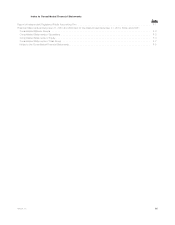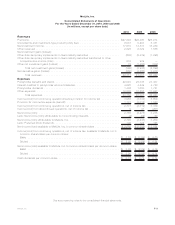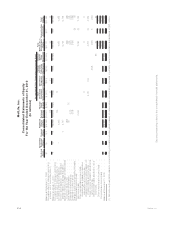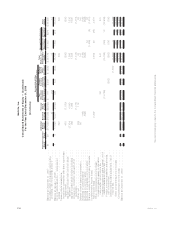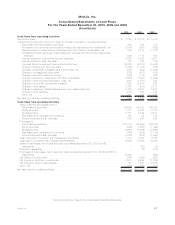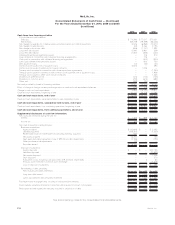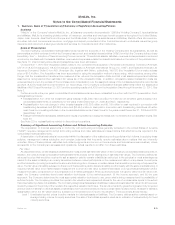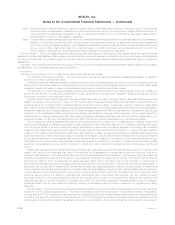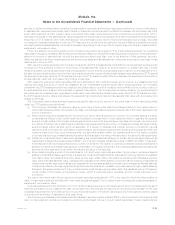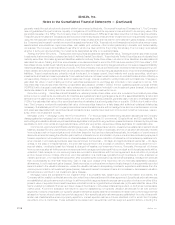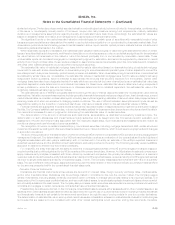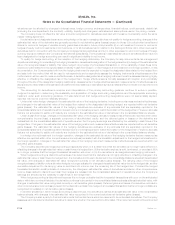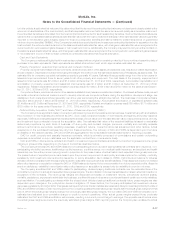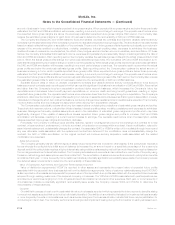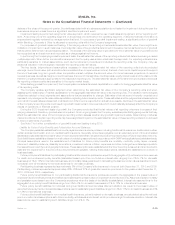MetLife 2010 Annual Report Download - page 98
Download and view the complete annual report
Please find page 98 of the 2010 MetLife annual report below. You can navigate through the pages in the report by either clicking on the pages listed below, or by using the keyword search tool below to find specific information within the annual report.MetLife, Inc.
Notes to the Consolidated Financial Statements
1. Business, Basis of Presentation and Summary of Significant Accounting Policies
Business
“MetLife” or the “Company” refers to MetLife, Inc., a Delaware corporation incorporated in 1999 (the “Holding Company”), its subsidiaries
and affiliates. MetLife is a leading global provider of insurance, annuities and employee benefit programs throughout the United States,
Japan, Latin America, Asia Pacific and Europe and the Middle East. Through its subsidiaries and affiliates, MetLife offers life insurance,
annuities, auto and homeowners insurance, mortgage and deposit products and other financial services to individuals, as well as group
insurance and retirement & savings products and services to corporations and other institutions.
Basis of Presentation
The accompanying consolidated financial statements include the accounts of the Holding Company and its subsidiaries, as well as
partnerships and joint ventures in which the Company has control, and variable interest entities (“VIEs”) for which the Company is the primary
beneficiary. See “— Adoption of New Accounting Pronouncements.” Closed block assets, liabilities, revenues and expenses are combined
on a line-by-line basis with the assets, liabilities, revenues and expenses outside the closed block based on the nature of the particular item.
See Note 10. Intercompany accounts and transactions have been eliminated.
On November 1, 2010 (the “Acquisition Date”), MetLife, Inc. completed the acquisition of American Life Insurance Company (“American
Life”) from ALICO Holdings LLC (“ALICO Holdings”), a subsidiary of American International Group, Inc. (“AIG”), and Delaware American Life
Insurance Company (“DelAm”) from AIG, (American Life, together with DelAm, collectively, “ALICO”) (the “Acquisition”) for a total purchase
price of $16.4 billion. The Acquisition has been accounted for using the acquisition method of accounting, which requires, among other
things, that the consideration transferred be measured at fair value at the Acquisition Date and that most assets acquired and liabilities
assumed be recognized at their estimated fair values as of the Acquisition Date. In addition, acquisition-related transaction costs are
expensed as incurred. Any excess of the purchase price consideration over the assigned values of the net assets acquired is recorded as
goodwill. ALICO’s fiscal year-end is November 30. Accordingly, the Company’s consolidated financial statements reflect the assets and
liabilities of ALICO as of November 30, 2010 and the operating results of ALICO from the Acquisition Date through November 30, 2010. See
Note 2.
Certain amounts in the prior years’ consolidated financial statements have been reclassified to conform with the 2010 presentation. Such
reclassifications include:
• Reclassification from other net investment gains (losses) of ($4,866) million and $3,910 million to net derivative gains (losses) in the
consolidated statements of operations for the years ended December 31, 2009 and 2008, respectively;
• Reclassification from net change in other invested assets of $3,292 million and $8,168 million to cash received in connection with
freestanding derivatives and ($5,393) million and ($6,454) million to cash paid in connection with freestanding derivatives, all within
cash flows from investing activities, in the consolidated statements of cash flows for the years ended December 31, 2009 and 2008,
respectively; and
• Realignment that affected assets, liabilities and results of operations on a segment basis with no impact to the consolidated results. See
Note 22.
See Note 23 for reclassifications related to discontinued operations.
Summary of Significant Accounting Policies and Critical Accounting Estimates
The preparation of financial statements in conformity with accounting principles generally accepted in the United States of America
(“GAAP”) requires management to adopt accounting policies and make estimates and assumptions that affect amounts reported in the
consolidated financial statements.
A description of critical estimates is incorporated within the discussion of the related accounting policies which follows. In applying these
policies, management makes subjective and complex judgments that frequently require estimates about matters that are inherently
uncertain. Many of these policies, estimates and related judgments are common in the insurance and financial services industries; others
are specific to the Company’s businesses and operations. Actual results could differ from these estimates.
Fair Value
As described below, certain assets and liabilities are measured at estimated fair value on the Company’s consolidated balance sheets. In
addition, the notes to these consolidated financial statements include further disclosures of estimated fair values. The Company defines fair
value as the price that would be received to sell an asset or paid to transfer a liability (an exit price) in the principal or most advantageous
market for the asset or liability in an orderly transaction between market participants on the measurement date. In many cases, the exit price
and the transaction (or entry) price will be the same at initial recognition. However, in certain cases, the transaction price may not represent fair
value. The fair value of a liability is based on the amount that would be paid to transfer a liability to a third party with the same credit standing. It
requires that fair value be a market-based measurement in which the fair value is determined based on a hypothetical transaction at the
measurement date, considered from the perspective of a market participant. When quoted prices are not used to determine fair value of an
asset, the Company considers three broad valuation techniques: (i) the market approach, (ii) the income approach, and (iii) the cost
approach. The Company determines the most appropriate valuation technique to use, given what is being measured and the availability of
sufficient inputs. The Company prioritizes the inputs to fair valuation techniques and allows for the use of unobservable inputs to the extent
that observable inputs are not available. The Company categorizes its assets and liabilities measured at estimated fair value into a three-level
hierarchy, based on the priority of the inputs to the respective valuation technique. The fair value hierarchy gives the highest priority to quoted
prices in active markets for identical assets or liabilities (Level 1) and the lowest priority to unobservable inputs (Level 3). An asset or liability’s
classification within the fair value hierarchy is based on the lowest level of input to its valuation. The input levels are as follows:
Level 1 Unadjusted quoted prices in active markets for identical assets or liabilities. The Company defines active markets based on
average trading volume for equity securities. The size of the bid/ask spread is used as an indicator of market activity for fixed
maturity securities.
F-9MetLife, Inc.


